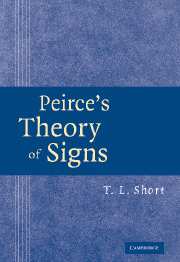Book contents
- Frontmatter
- Contents
- Preface
- Acknowledgments
- 1 Antecedents and Alternatives
- 2 The Development of Peirce's Semeiotic
- 3 Phaneroscopy
- 4 A Preface to Final Causation
- 5 Final Causation
- 6 Significance
- 7 Objects and Interpretants
- 8 A Taxonomy of Signs
- 9 More Taxa
- 10 How Symbols Grow
- 11 Semeiosis and the Mental
- 12 The Structure of Objectivity
- Bibliography
- Name Index
- Subject Index
2 - The Development of Peirce's Semeiotic
Published online by Cambridge University Press: 28 July 2009
- Frontmatter
- Contents
- Preface
- Acknowledgments
- 1 Antecedents and Alternatives
- 2 The Development of Peirce's Semeiotic
- 3 Phaneroscopy
- 4 A Preface to Final Causation
- 5 Final Causation
- 6 Significance
- 7 Objects and Interpretants
- 8 A Taxonomy of Signs
- 9 More Taxa
- 10 How Symbols Grow
- 11 Semeiosis and the Mental
- 12 The Structure of Objectivity
- Bibliography
- Name Index
- Subject Index
Summary
This chapter serves several purposes. The first is to show that Peirce's 1868–9 doctrine of thought-signs was deeply flawed, that its flaws were apparent to him, and that he corrected them in divers steps over many years, the process not being completed until 1907. Although similar in form, his mature semeiotic is different in conception from his early semeiotic. Prevailing interpretations of Peirce's semeiotic have resulted from inattention to, or in some cases from heroic denial of, contradictions among writings of different dates.
A second purpose is to demonstrate that Peirce's semeiotic was developed with an eye to theories of knowledge and of mind; it was intended to be a department of philosophy, not a general science of human culture, à la Saussure's semiology. Its context, initially, was Kantian, and the problem that most exercised Peirce was posed by Kant's doctrine that objects not constituted by thought (i.e., not a function of or determined by thought's essential structure) are unknowable. Within the world constituted by thought, we can distinguish the mental and the physical; hence, both are knowable. But behind them, Kant said, there are ‘things in themselves’, inaccessible to science. Throughout his career, Peirce consistently rejected Kant's claim that there is an unknowable. However, there are two ways of doing that: one is to deny that there is anything not constituted by thought; the other is to assert that we can know things not constituted by thought.
- Type
- Chapter
- Information
- Peirce's Theory of Signs , pp. 27 - 59Publisher: Cambridge University PressPrint publication year: 2007



